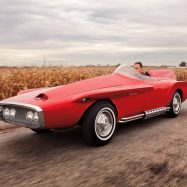1960 Plymouth XNR

Since last week’s feature, I’ve been hunting for the bottom of the Virgil Exner rabbit hole. It’s a tough assignment because Virgil’s design language isn’t congruent with my own. I’ve spent my life championing form entwined with function while Virgil seemingly threw caution to the wind and drew shapes without so much as a consideration for usability.
Case in point, the Plymouth XNR. Virgil conjured this beast just as the Thunderbird was veering toward luxury and the Corvette was gearing up for a performance overhaul. You gotta wonder, did he ever contemplate the wisdom of his boss, the legendary Walter P. Chrysler, who once barked, “We build cars to sit in, not to piss over”?
Virgil’s muse for the XNR was a Studebaker he had whipped up a decade prior, but he threw in a motley mix of styling borrowed from modern Indy roadsters, a dash of Italian pizzazz straight from the Ferrari playbook, and even a pinch of Jaguar intrigue. And he didn’t just want it to look fast; he wanted it to flat-out scream speed. They built it on a truncated Valiant chassis, slapped together with prototype suspension and brake components, all juiced up by a hot-rodded 225-inch slant-six engine that was pushing out a ferocious 250 horses. Of course, a manual gearbox was par for the course. And if you had the stones to run through all the gears and hit that 7500 RPM redline, you were tearing through the air at a blistering 150mph.
In 1960, Motor Trend’s scribes couldn’t contain themselves, exclaiming, “Corvettes beware! This radical creation, the XNR, still in experimental stage, is full of new ideas that Chrysler hopes to incorporate into its future sports car.” And when this automotive dream rocket hit the show circuit, rumor has it Bill Mitchell, the brains behind the Corvette, raised an eyebrow and took a page or two of inspiration from Virgil’s sketchpad.
By 1961, however, the suits did what suits do and killed the project claiming they didn’t foresee enough volume in the market to support a sports car. Virgil’s heart was left in tatters, and he desperately wanted to keep the beast, but… Suits. So, they shipped the car off to Carrozzeria Ghia in Italy, the place where the sheet metal was first formed. From there, it embarked on a globetrotting adventure, bouncing from one Shah’s garage to another for a few decades.
Ultimately, the XNR found itself in the war-torn, explosive chaos of Beirut, where it had to dodge Molotov cocktails, hand grenades, and guerrilla warfare for many heart-pounding years under the watchful eye of Karim Edde. When the dust finally settled after the war, Edde went shopping for restoration wizards, and his quest led him to the artisans at RM Restorations in France. I can only imagine the astronomical price tag on that bill, but the end result, well… The work is so damned nice that I can appreciate the car despite lines I don’t.




















